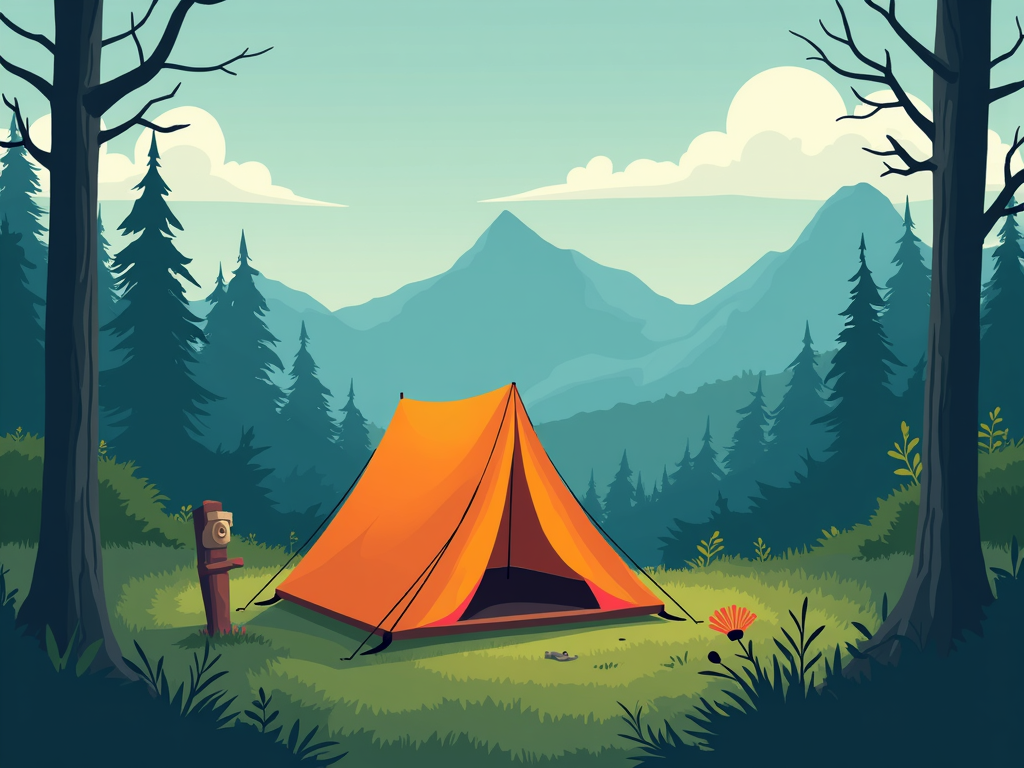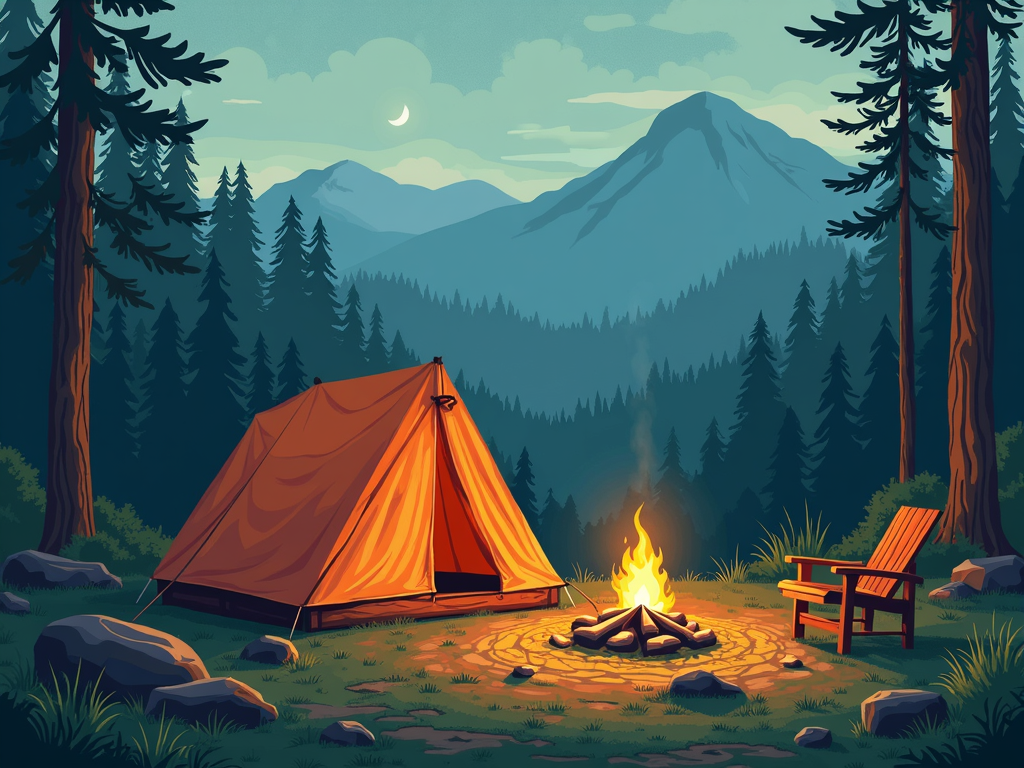Here’s the dirty little secret nobody talks about: most primitive campers are liars.
They preach about disconnecting from technology while secretly checking their phones behind trees. They brag about roughing it but panic when their GPS dies.

And you know what? They’re not wrong to bring that tech.
Last year, 73% of backcountry emergencies could’ve been prevented with basic GPS devices, according to the National Forest Service. That’s real people getting lost, hurt, or worse because they bought into the fantasy that ‘real’ wilderness camping means zero technology.
The truth is messier. And more interesting.
This guide isn’t about choosing between Bear Grylls machismo and car camping comfort. It’s about finding that sweet spot where technology enhances rather than ruins your wilderness experience. Where safety meets solitude. Where Instagram doesn’t exist but emergency beacons do.
The Technology Paradox: Why Your Smartphone Might Save Your Primitive Camping Experience
Let’s start with the elephant in the tent: technology guilt.
You know that feeling when you’re 20 miles into the backcountry, surrounded by nothing but pine trees and silence, and you catch yourself checking for cell signal? Yeah, that shame spiral.
Here’s what Les Stroud won’t tell you on Survivorman: even he carries satellite communication devices. The difference? He knows when to use them.
The National Forest Service just dropped some sobering data: nearly three-quarters of their search and rescue operations could’ve been avoided if people carried basic GPS devices. Not fancy gear. Just something that shows your location when you’re convinced that tree stump looked different an hour ago.
But here’s where it gets interesting.
Psychologists studying outdoor recreation found that going cold turkey on technology actually makes people more anxious in the wilderness. Not less. The brain freaks out without its digital pacifier.

Smart primitive camping isn’t about abandoning all technology. It’s about choosing your tech like you choose your gear: deliberately.
A Garmin inReach Mini weighs 3.5 ounces. That’s less than your camp spoon. But it can literally save your life when you’re practicing dispersed camping for beginners.
Same with offline maps on your phone. Download them before you leave civilization, switch to airplane mode, and boom—you’ve got navigation without the constant notification buzz.
The real skill isn’t living without technology. It’s knowing when technology serves you versus when you’re serving it. That weather alert at 3 AM when a storm’s rolling in? Useful. Checking Instagram while watching the sunset? You’re missing the whole point.
But technology is just one piece of the mental game. The real wilderness exists between your ears.
The Mental Wilderness: Preparing Your Mind for True Off-Grid Living
Nobody warns you about the panic.
Day two of your first dispersed camping trip, when you realize the nearest human is 15 miles away and your brain starts playing every horror movie you’ve ever seen.
Outdoor education programs report that 40% of first-timers experience unexpected anxiety or straight-up fear in remote settings. That’s almost half. And these aren’t weak people—they’re folks who thought they were ready for off grid camping tips.
The Bureau of Land Management doesn’t include ‘mental preparation’ in their dispersed camping guidelines. REI won’t sell you confidence. But without it, all the gear in the world won’t help.
Les Stroud talks about this constantly: the mental game is everything in survival camping techniques.
Your brain is wired for civilization. For knowing help is a phone call away. Strip that safety net, and primitive parts of your mind wake up. The ones that kept your ancestors alive but now just make you paranoid about that rustling bush.
Here’s what actually works: gradual exposure.
Don’t go from car camping to a week alone in the wilderness. Start with one night, close enough to your car that you could bail. Then push further. Your brain needs time to recalibrate what ‘normal’ feels like.
Practice being bored at home first. Seriously. Sit in your backyard for an hour without your phone. If you can’t handle that, you’re not ready for three days in the backcountry.
The technology you bring can serve as training wheels for your mind. Knowing you have an emergency beacon reduces anxiety enough to actually enjoy the experience. Over time, you need it less. But starting without it? That’s not brave. It’s dumb.
The strongest primitive campers aren’t the ones who need nothing. They’re the ones who know exactly what they need and why. That’s real primitive camping safety.
Speaking of knowing what you need, let’s talk about what happens when everyone starts needing the same remote spots.
Beyond Leave No Trace: The New Ethics of Crowdsourced Wilderness
Instagram ruined primitive camping.
There, I said it.
The BLM reports a 300% increase in dispersed camping at spots tagged on social media. Three hundred percent. These aren’t just numbers—they’re tire tracks through cryptobiotic soil that takes decades to recover. They’re human waste where there used to be none. They’re the reason your secret spot now has a line of Sprinter vans.
But here’s the plot twist: going off-grid doesn’t mean going dark anymore.
The National Forest Service and BLM adapted. Digital permits, online reservation systems, even QR codes at trailheads. The same technology that created the problem is becoming part of the solution.
Leave No Trace used to be simple: pack out your trash, don’t feed wildlife, minimize campfire impact. Now it includes your digital footprint. That gorgeous sunrise photo from your stealth camping spot? Congratulations, you just invited 10,000 strangers to trash it.
The new ethics are more complex.
Tag general areas, not specific coordinates. Use apps like Gaia GPS to find spots, but don’t broadcast them. Think of wilderness locations like your friend’s secrets—just because you know doesn’t mean you should tell.
Here’s what most people miss: dispersed camping isn’t actually free-for-all camping. Every National Forest has rules. Every BLM district has guidelines. That ‘wild’ camping spot might require backcountry camping permits you can only get online. Ignorance isn’t an excuse when rangers write tickets.
The Appalachian Trail and Pacific Crest Trail communities figured this out years ago. They use codes, general descriptions, and word-of-mouth instead of exact GPS coordinates. Smart primitive campers are adopting the same approach.
Your Instagram feed doesn’t need to know exactly where you found solitude.
So how do you balance all this? Technology, mental preparation, and ethical considerations? You need a framework.
The S.M.A.R.T. Framework for Modern Primitive Camping
Forget everything you think you know about wilderness camping essentials.
The old rules—minimal gear, maximum suffering—came from a different era. When getting lost meant staying lost. When weather surprises killed people. When nobody knew where the good free camping spots were anyway.
Today’s primitive camping requires a smarter approach. I call it the S.M.A.R.T. framework:
Strategic tech use means picking devices that multiply your capabilities without creating dependencies. A Sawyer water filter beats iodine tablets. An MSR stove beats hoping you can start a fire in the rain.
Minimal doesn’t mean nothing. It means everything serves multiple purposes. Your phone becomes camera, map, weather radio, and emergency beacon. One device, five functions.
Adaptive planning acknowledges that conditions change. That perfect primitive campsite setup might flood. Your water source might dry up. Smart campers have Plan B without carrying two of everything.
Resilient systems have backups that don’t add weight. Paper maps for when batteries die. Basic compass skills for when GPS glitches. Knowledge weighs nothing.
Technology serves you, not the other way around. Use it to enhance safety and enjoyment, not to insulate yourself from the experience.
This isn’t minimalist camping advice from purists who’ve never faced real emergencies. It’s practical wisdom from people who’ve learned the hard way.
Patagonia doesn’t make gear for people who want to suffer. They make it for people who want to explore safely. There’s a difference.
Essential Gear That Actually Matters (And What’s Just Marketing BS)
Your primitive camping gear list is probably 60% unnecessary.
Here’s the brutal truth: most backcountry camping guide recommendations come from companies trying to sell you stuff. That titanium spork? Nice, but a plastic spoon works fine. The $300 ultralight tent? Great, until it shreds in wind.
After thousands of nights in the wilderness, here’s what actually matters:
Water filtration trumps everything. You can survive without food for weeks. Without clean water? Three days, max. Sawyer Mini filters weigh 2 ounces and clean 100,000 gallons. That’s not marketing. That’s physics.
Shelter comes second. But not the shelter you think. Your biggest threat isn’t rain—it’s wind. A cheap tarp pitched right beats an expensive tent pitched wrong.
Fire starting seems primitive until you’re hypothermic. Carry three methods: lighter, matches, ferro rod. Bushcraft camping tips are cute until your hands are too numb for friction fires.
Navigation can’t depend on batteries alone. Phone dies. GPS glitches. But that paper map and $10 compass? They’ll work until the sun explodes.
First aid kits full of bandaids are worthless. Learn to use duct tape, super glue, and ibuprofen. Most wilderness medicine is improvisation anyway.
Communication devices aren’t optional anymore. A personal locator beacon costs less than one helicopter search hour. Do the math.
Everything else? Comfort items. Nice to have, not need to have.
The best primitive camping food ideas are boring: calories per ounce. Forget gourmet. Think peanut butter, instant noodles, energy bars. Your taste buds won’t care after hiking 20 miles.
Making It Real: Your Next Steps Into True Wilderness
Primitive camping in 2024 isn’t your grandfather’s wilderness experience.
It’s messier, more complex, and honestly, more honest.
The S.M.A.R.T. framework—Strategic, Minimal, Adaptive, Resilient Technology—isn’t about choosing sides in some imaginary battle between purists and tech lovers. It’s about being smart enough to use every tool available while still finding what you came for: that raw connection to the wild.
Your next step? Pick one National Forest or BLM area within two hours of home. Download the offline maps. Research the dispersed camping rules and wilderness camping regulations. Plan a single night out there—close enough to bail if needed, far enough to feel it.
Bring your phone, but keep it on airplane mode. Pack that emergency beacon without shame. Set up your primitive campsite before dark. Practice your water filtration system at home first.
Because the best primitive camping tip isn’t about gear or apps or Leave No Trace principles. It’s about being honest about what you need to feel safe enough to actually experience the wilderness.
Everything else is just details.
The wilderness is still wild. You just need to be smart about finding it.
And maybe, just maybe, that smartphone in your pocket isn’t the enemy of primitive camping. Used right, it might be exactly what lets you go deeper into the wild than ever before.
Without dying.